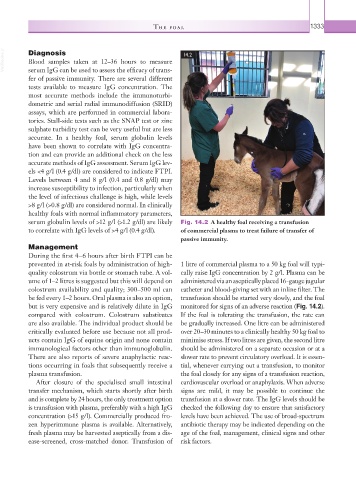Page 1358 - Equine Clinical Medicine, Surgery and Reproduction, 2nd Edition
P. 1358
The foal 1333
VetBooks.ir Diagnosis 14.2
Blood samples taken at 12–36 hours to measure
serum IgG can be used to assess the efficacy of trans-
fer of passive immunity. There are several different
tests available to measure IgG concentration. The
most accurate methods include the immunoturbi-
dometric and serial radial immunodiffusion (SRID)
assays, which are performed in commercial labora-
tories. Stall-side tests such as the SNAP test or zinc
sulphate turbidity test can be very useful but are less
accurate. In a healthy foal, serum globulin levels
have been shown to correlate with IgG concentra-
tion and can provide an additional check on the less
accurate methods of IgG assessment. Serum IgG lev-
els <4 g/l (0.4 g/dl) are considered to indicate FTPI.
Levels between 4 and 8 g/l (0.4 and 0.8 g/dl) may
increase susceptibility to infection, particularly when
the level of infectious challenge is high, while levels
>8 g/l (>0.8 g/dl) are considered normal. In clinically
healthy foals with normal inflammatory parameters,
serum globulin levels of >12 g/l (>1.2 g/dl) are likely Fig. 14.2 A healthy foal receiving a transfusion
to correlate with IgG levels of >4 g/l (0.4 g/dl). of commercial plasma to treat failure of transfer of
passive immunity.
Management
During the first 4–6 hours after birth FTPI can be
prevented in at-risk foals by administration of high- 1 litre of commercial plasma to a 50 kg foal will typi-
quality colostrum via bottle or stomach tube. A vol- cally raise IgG concentration by 2 g/l. Plasma can be
ume of 1–2 litres is suggested but this will depend on administered via an aseptically placed 16-gauge jugular
colostrum availability and quality; 300–500 ml can catheter and blood-giving set with an inline filter. The
be fed every 1–2 hours. Oral plasma is also an option, transfusion should be started very slowly, and the foal
but is very expensive and is relatively dilute in IgG monitored for signs of an adverse reaction (Fig. 14.2).
compared with colostrum. Colostrum substitutes If the foal is tolerating the transfusion, the rate can
are also available. The individual product should be be gradually increased. One litre can be administered
critically evaluated before use because not all prod- over 20–30 minutes to a clinically healthy 50 kg foal to
ucts contain IgG of equine origin and none contain minimise stress. If two litres are given, the second litre
immunological factors other than immunoglobulin. should be administered on a separate occasion or at a
There are also reports of severe anaphylactic reac- slower rate to prevent circulatory overload. It is essen-
tions occurring in foals that subsequently receive a tial, whenever carrying out a transfusion, to monitor
plasma transfusion. the foal closely for any signs of a transfusion reaction,
After closure of the specialised small intestinal cardiovascular overload or anaphylaxis. When adverse
transfer mechanism, which starts shortly after birth signs are mild, it may be possible to continue the
and is complete by 24 hours, the only treatment option transfusion at a slower rate. The IgG levels should be
is transfusion with plasma, preferably with a high IgG checked the following day to ensure that satisfactory
concentration (>15 g/l). Commercially produced fro- levels have been achieved. The use of broad-spectrum
zen hyperimmune plasma is available. Alternatively, antibiotic therapy may be indicated depending on the
fresh plasma may be harvested aseptically from a dis- age of the foal, management, clinical signs and other
ease-screened, cross-matched donor. Transfusion of risk factors.

